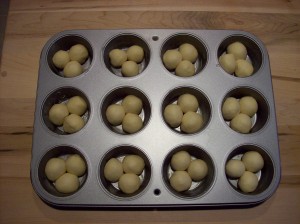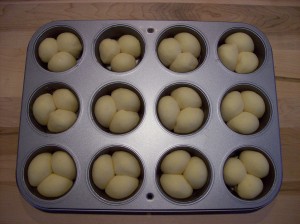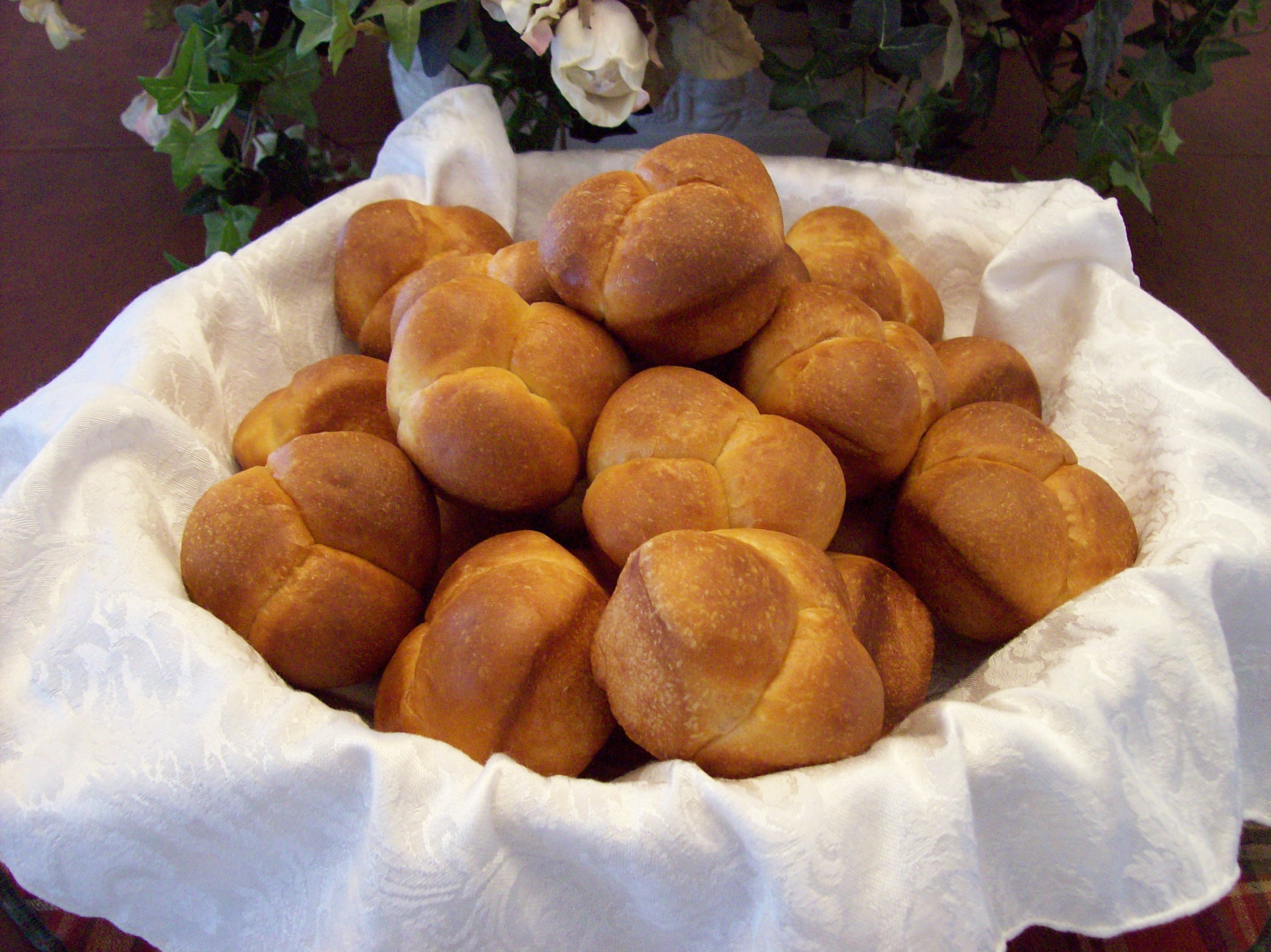Cloverleaf Rolls
Dec 26th, 2008 by SteveB
For some reason, dinner rolls have always been the preferred style of bread at my family’s holiday table. Perhaps it’s simply the comfort of tradition. Or maybe the reason is a bit more utilitarian; the convenient individual serving size saves the space needed to slice bread at the table and makes it easier for everyone to help themselves.
Among the many types of dinner rolls, cloverleaf rolls make an ideal accompaniment to a holiday meal. They are quick and easy to make, plus they have a rich, buttery flavor. Their 3-lobed design also lends a festive look to any holiday table.
The formula used here is a modification of the one described for Soft Butter Rolls in Hamelman’s Bread: A Baker’s Book of Techniques and Recipes. Note that with this formula, I have started using King Arthur Organic Select Artisan Flour, with a protein content of 11.3%. This lower protein content is closer to that of a French Type 55 flour. Any observed performance differences, as compared to King Arthur All Purpose Flour, will be reported in subsequent posts.
Final Dough
- 500 g King Arthur Organic Select Artisan Flour
- 230 g Water
- 1 Large Egg
- 40 g Butter (softened)
- 2 Tbs. Sugar
- 3 Tbs. Dry Milk Powder
- 2 Tsp. Salt
- 1 Tsp. Instant Dried Yeast
All the ingredients are placed in the bowl of a home stand mixer fitted with a spiral dough hook and the mixer is run at speed 2 until all the ingredients are incorporated, about 3 minutes. The mixer is then set on speed 3 and mixing is continued until the gluten is moderately developed, about 7 minutes. The target temperature of the final dough is 76şF.
The dough is then placed in a lightly oiled container, covered and fermented for 1 hour. At the end of the 1 hour fermentation, the dough is divided into pieces weighing 40 g and each 40 g piece, in turn, is divided into thirds. Each smaller piece is then tightly rounded and placed, 3 to a cup, into the cups of a lightly greased muffin tin (two, 12-cup tins will be required) as shown below:

The tins are placed in a proof box and the dough allowed to proof for 1˝ hours at 76şF, just until the dough feels light to the touch, as seen below:

The proofed rolls are then brushed with melted butter and baked in a 400şF oven for 15 minutes. After removing from the oven, the rolls are once again brushed with melted butter. The muffin tins are then inverted, yielding approximately 20 rolls.

That is a lovely basket of rolls, perfect for a holiday table. Happy holidays to you and your family.
Those are really pretty and as you say, practical! I can definitely see the appeal for a holiday meal. They look like they’d be really light and fluffy inside. Great idea.
Adorables petits pains!
I hope your Christmas Dinner was all the way as good as those little breads seem to be.
At my parents table, I had brought a Pain Normand made following your recipe. We ate it thinly sliced with a homemade Foie Gras (poor little fattened duckie, I know…. I wouldn’t have bought it myself but I must confess I cooked it and was delighted to eat some… ), and it was excellent, thanks again Steve!
11.3 protein content is even HIGHER than most T65 French wheat flours! The T65 flours one can buy in ordinary supermarkets is usually between 9 and 10.5%… And no one officially recommends adding gluten to flour when baking bread… I write “officially” because French professional bakers usually bake with flours that contain added malt, gluten, among other things.
Susan, thanks for the kind words and holiday wishes. I hope you and your family enjoy the remainder of the holiday season and I wish you the best that 2009 has to offer.
Jane, oops… I guess I forgot to show the crumb on these. You are right, though, they did turn out light and fluffy.
Flo, I can always count on you to bring some class to this blog (“petits pains” has a much more elegant sound than “dinner rolls”). 🙂
Your Pain Normand with foie gras sounds scrumptious!
Thanks for the information on French T65 protein content. I had no idea it was that low. I’m hoping to bake with some authentic French T65 shortly and will let you know how it compares to a typical U.S. flour.
STEVE,vos petits pains individuels sont tres beaux.votre famille les a ,surement tres appreciÁ©s car en plus d’etre parfaits ils devaient etre tres tres bons!POURle repas de ,noel,ma belle-mÁ©re avait mis sur chaque assiette une jolie serviette blanche &dessus,un petit pain ce qui a donnÁ© une table de fÁŞte tres classe.Je vous souhaite pour 2009 une trs bonne annÁ©e &beaucoup de beaux pains
Christiane, vos belle-mÁ¨re fixe un table trÁ¨s Á©lÁ©gant!
Merci beaucoup pour vos souhaite de nouvel an. J’espÁ¨re que vous et vos famille avez une trÁ¨s bonne 2009.
These rolls look deliciously fat and plump. They must be a joy to bite into. What a great holiday tradition!
MC
The rolls look perfect. Nice job!
Perhaps I should make some with 4 pieces to a muffin cup, for luck?
Happy new year! Wishing you a great one.
FP
Thanks, FP. Best of the new year to you as well!
Steve, I’m having so much success with your recipes. My mother also made cloverleaf rolls for holiday dinners using a recipe from the old Purity Flour Cookbook. I did your recipe last night and they were/are wickedly good. The only thing I did differently was to brush them with melted butter right after forming, rather than right before baking. No harm done! Many thanks.
[…] you are required to produce a soft roll recipe with three different shapes– one being a Cloverleaf shape. It was then, that I decided to include this neat little shape to my daily bread basket, […]
[…] but I was lacking the required muffin tins. Turned out cute anyway, and super yummy. Followed the recipe from Bread cetera, with slight variations (the ingredients were still the same, just the milk powder being […]
You made some decent points there. I looked on the internet for
more information about the issue and found most individuals will go along with your views on this website.